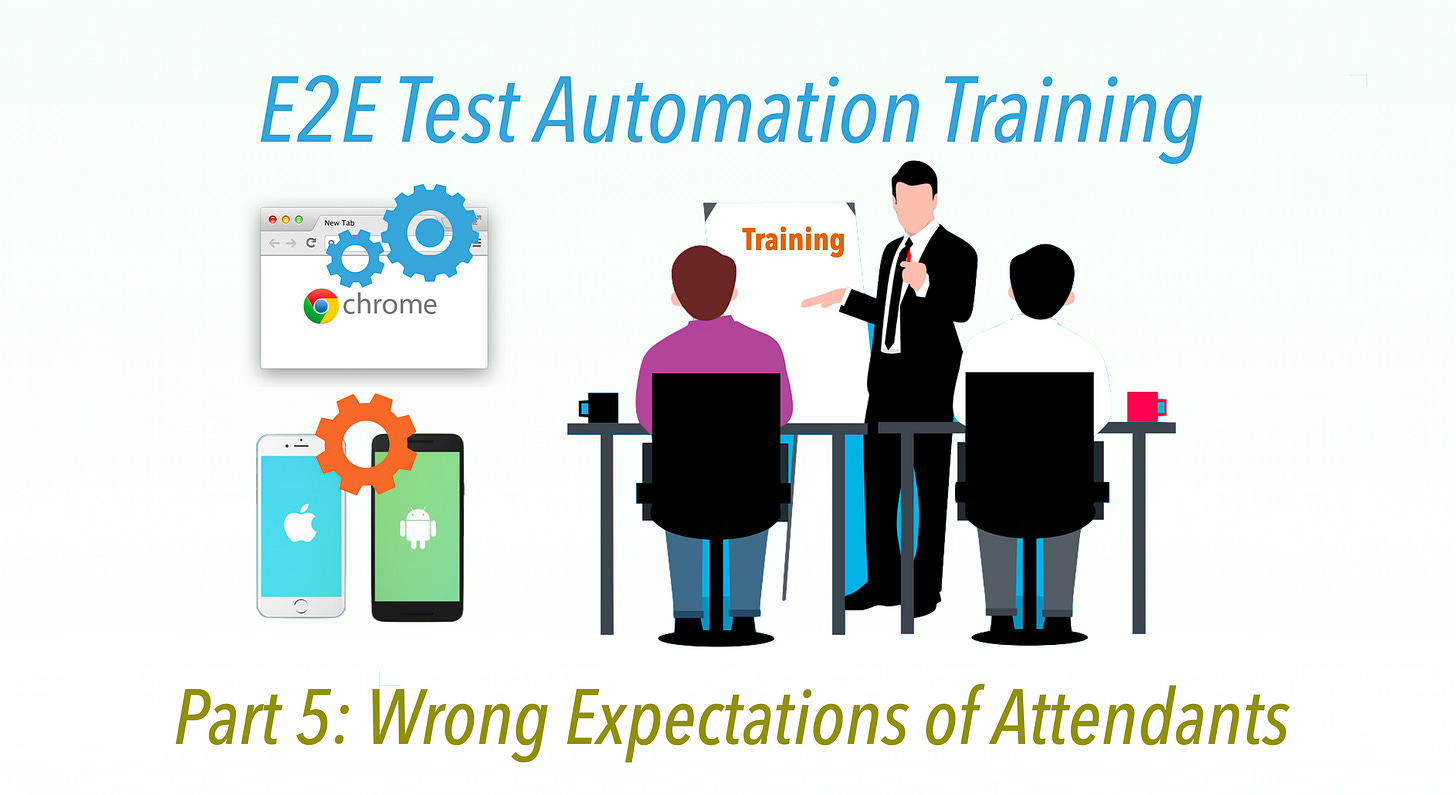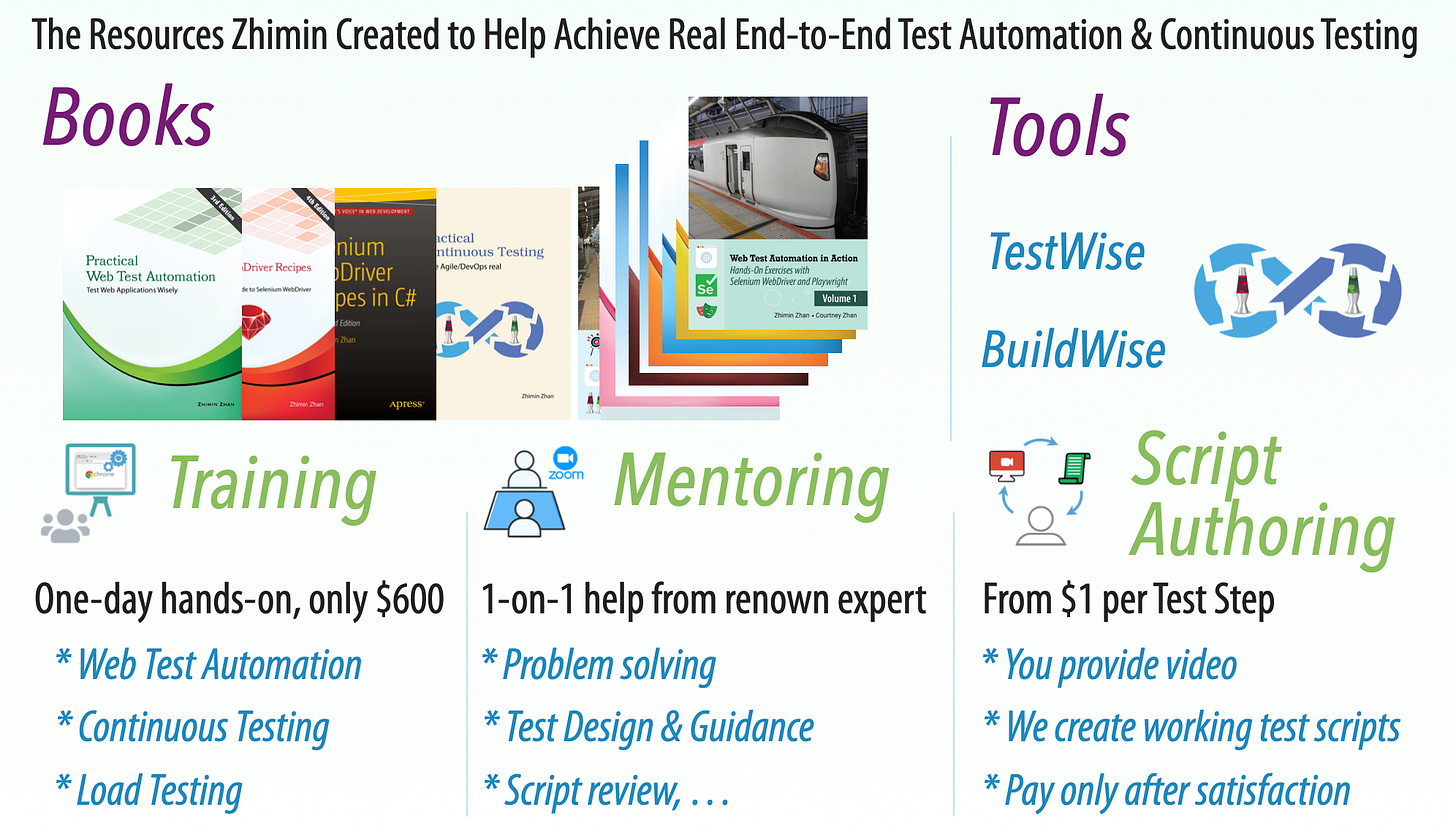Why Are Most E2E Test Automation Training Not Effective? Part 5: Wrong Expectations of Attendants
Be clear about your specific goals to avoid being misled.
In this series:
Part 1: Unqualified Instructor, often not even a Dedicated One
Part 2: Wrong Content: Overloaded with Theory, Lacking Practical Hands-On
Part 3: Expensive
Part 5: Wrong Expectations of Attendants
Part 6: Advice
Part 7: FAQ
In past articles, I listed the factors that contributed to the poor reception of E2E test automation. As a result, there are not many companies offering it and software companies or individuals did not cross the mind while test automation skills are severely lacking in most companies.
In this article, I will point out the factors (i.e. mistakes) on the customers’ side.
Table of Contents:
· 1. Often Ask Agile Consulting Companies to Provide Training on E2E Test Automation.
· 2. Fall in influencers Who can only talk.
· 3. Did not choose a specific framework.
· 4. Attendants Care for a ‘Certificate’ rather than Learning Real.
1. Often Ask Agile Consulting Companies to Provide Training on E2E Test Automation.
This is quite common and unfortunate. As you may know, many so-called "Agile" consulting companies send their consultants to serve as Agile coaches or Scrum Masters.
In the middle of software development, the importance of E2E testing becomes increasingly evident, often outweighing the focus on coding. During this time, managers at client companies may turn to these fake "Agile Coaches" for guidance. In response, these bogus agile consulting firms create so-called test automation training programs, despite having little knowledge and never having witnessed a real E2E test automation success.
2. Fall in influencers Who can only talk.
There are two types of people: talkers and doers. Only a small percentage excel at both communication and hands-on execution. E2E test automation is a field that heavily relies on practical, hands-on expertise.
However, it's easy to be swayed by sales pitches or demonstrations from talkers. Why? Because creating an impressive E2E test automation demo is relatively easy. I have witnessed a few of those using HP QuickTestPro, IBM Rational Functional Tester, Microsoft Coded UI Test, PhantomJS and Protractor. All of those test automation tools/frameworks are discontinued.
I have to admit, some of those presenters (often with impressive titles) are excellent speakers. If I hadn’t gained years of hands-on experience with E2E test automation, I’d probably be fooled by them too.
One inherent aspect of E2E test automation is that creating a few tests is easy, but maintaining a large test suite is challenging.
In other words, many self-acclaimed test automation experts are fake.
“95% of the time, 95% of test engineers will write bad GUI automation just because it’s a very difficult thing to do correctly”.
- this interview from Microsoft Test Guru Alan Page (2015), author of “How we test software at Microsoft”“Testing is harder than developing. If you want to have good testing you need to put your best people in testing.”
- Gerald Weinberg, software legend, in a podcast (2018)
So, before engaging a training, test your instructor first. Asking for evidence like this: “Showcase a 500+ End-to-End (via UI) Test Suite: E2E Test Automation is Surely Feasible for Large/Complex Apps”.
3. Did not choose a specific framework.
In Part 2, I shared the content of a 2-day training, all generic stuff. Now with ChatGPT, people now realise that AI probably can create better generic training stuff.
From another perspective, if a software team or company decides to adopt E2E test automation, shouldn’t the framework be chosen first? Why not select a training program that’s specifically tailored to your needs?
Take web test automation, the most common form, as an example. There are two choices: Selenium WebDriver and Playwright.
Why not ask the instructor to teach your staff how to write and maintain automation scripts that actually work for your app? Wouldn’t that make more sense, rather than listening to someone read slides about the "pros and cons of Selenium and Playwright"?
4. Attendants Care for a ‘Certificate’ rather than Learning Real.
At an international software testing conference, after getting along well with the organizer, I said to her, "I’ve noticed that a high percentage of attendees, even in the workshops, aren’t there for the knowledge but rather to take a few days off work and add something to their resume." The organizer was initially surprised by my directness, but then she nodded in agreement.
Certification in Agile is by default prohibited by Agile Creators. To my knowledge, there is no formal certification by Agile Alliance. Check out the article, “Agile Certifications are Wrong!”.
Kent Beck, the father of Agile, described the dubious training-then-certified process in this interview.
“You attend a 2 day training, and you get this title, and you can put CSM: Certified Scrum Master after your name, and it didn’t actually mean anything. It should have been AST: Attended Scrum Training….but certified, whoa, who doesn’t want to be certified…Scrum, okay, already with the branding. Master! Who doesn’t want to be a Master? It’s a lie though. After two days, you’re not a master, anyone who certifies you is lying, and to me that whole edifice, certified scrum trainers, certified scrum trainer trainers, and then blah blah blah, it’s starting to look like a Pyramid Scheme to me. And none of it is honest. It’s built on this “hey, I want to look better than I actually am”….and I brought this up at the time, and the answer was “but nobody would come to the classes then!” Okay? And then…? I’m not clever enough to build an edifice on deceit. And this is going to piss some people off…I’m back! I’m off the goat farm. Look out!”
–Kent Beck (2019–10–15) (video)
Related reading:








